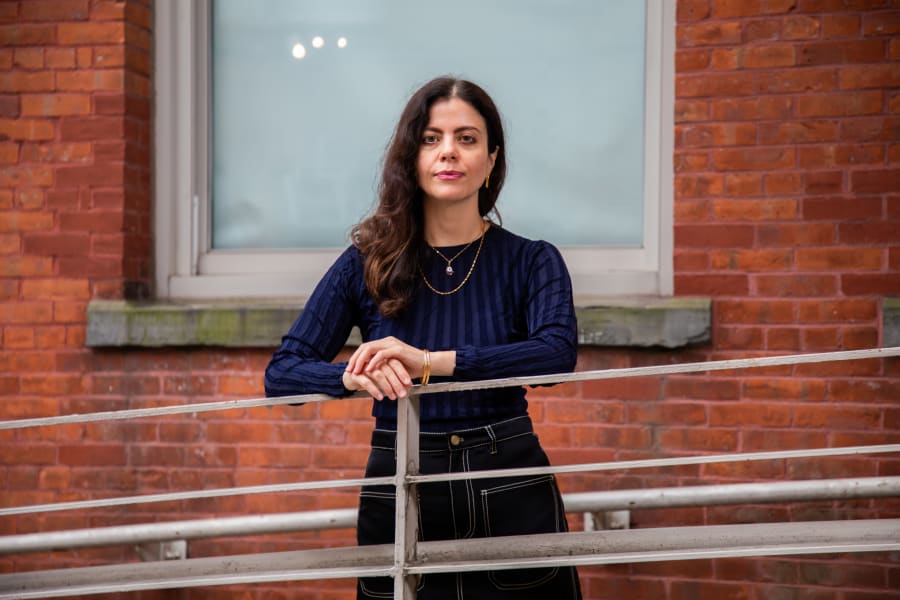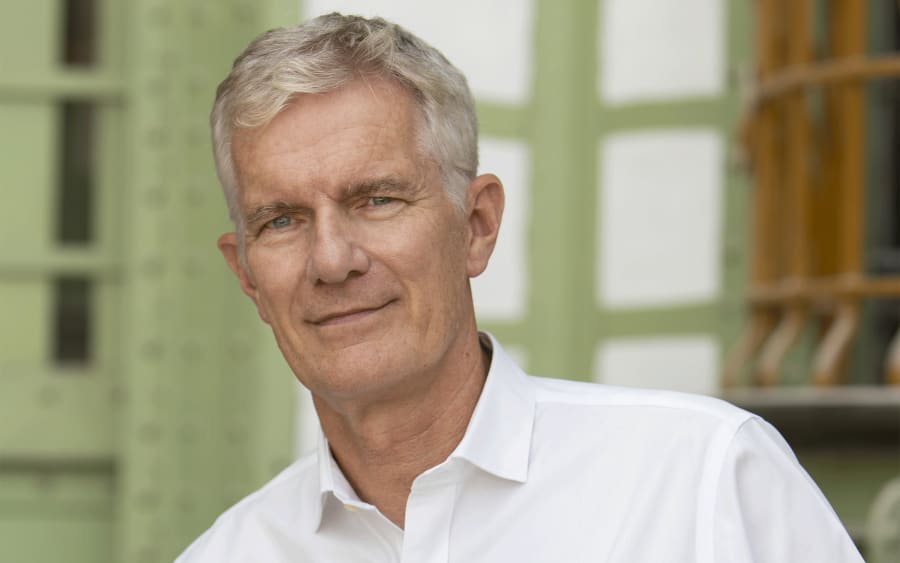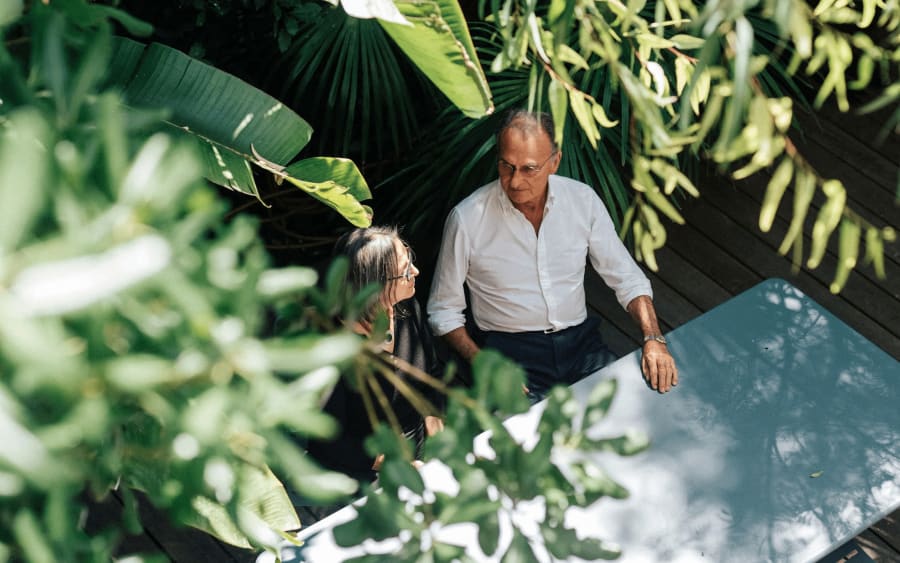The 36th edition of the Bienal de São Paulo, the second-oldest exhibition of its type in the world after the Venice Biennale, opens on September 6 at its customary Oscar Niemeyer-designed home in the Brazilian metropolis’ Ibirapuera Park. Featuring a curatorial team made up of Alya Sebti, Anna Roberta Goetz, and Thiago de Paula Souza, and helmed by chief curator Bonaventure Soh Bejeng Ndikung, it takes the title ‘Not All Travellers Walk Roads – Of Humanity as Practice’.
Among those alternative routes, waterways have proved particularly febrile inspiration for the curators, three of whom Art Basel spoke to as they were surrounded by crates and shipping boxes arriving from all corners of the world. ‘The metaphor of the estuary is very important for us,’ Goetz says. ‘The idea of how different rivers and waters flow into each other, how that creates this very special, very fruitful, ecosystem.’ This, they say, is reflected in how the work of the 120 artists gets installed across the three floors of the pavilion. ‘We want the visitor to feel that they are zooming in and zooming out in terms of the stories that are being told. How these so-called big themes are found in the everyday life experience of people.’ In the spirit of zooming in and out, Art Basel took a closer look at just a few of the artists to look out for
Vilanismo
A group of a dozen young Black artists who have been operating a studio collective in downtown São Paulo since 2021, Vilanismo will relocate to the Bienal for its duration. They take inspiration from the ‘villain’ figure, a motif which populates rap and funk culture on the periphery of the city, and use it to explore ways of making art in what they consider an exclusionary art world. Souza says that the group, as well as making space for themselves, poses a series of questions for the wider ecosystem in the country on how an institution might be reconceived to serve artists better, especially those who do not come from money or privilege.
Josèfa Ntjam
A highlight of the collateral events at the 2024 Venice Biennale was Josèfa Ntjam’s swell of spæc(i)es, a vast immersive digital video installation – an ambitious world-building project that took inspiration from plankton and speculative, mythological, marine biology. In Brazil, Ntjam returns to the water with a new single-channel video and a series of sculptures. ‘The Bienal Pavilion is both amazing and a very hard space to work with, so we wanted to imagine it as an estuary in itself, the artists populating that ecosystem,’ Souza says.
Gervane de Paula
For a long time, Gervane de Paula’s work was disregarded as arte popular. His paintings of his local neighborhood in Cuiabá and his animal sculptures, honed from wood he sources disregarded around the local area, were misread as naive, misunderstanding the acute political and satirical edge they had (as well as what Souza calls ‘a crazy sense of humor’). A recent retrospective at Pinacoteca de São Paulo revealed how de Paula burlesques the bucolic idea of the Pantanal region, undercutting rural clichés surrounding Brazil’s hinterland with a sense of violence.
Heitor dos Prazeres
This is a return for the painter and samba star to the Bienal, albeit a long-awaited one: Heitor dos Prazeres was included in the first and second editions, in 1951 and 1953. The curators have delved into both his and the Bienal’s archives to discover a much more multi-hyphenated artist than perhaps he was later given credit. While dos Prazeres cofounded one of the oldest and most successful samba schools in Rio and is beloved for classics such as Vai Saudade, Alya Sebti says that ‘there was a total freedom to his artistic approach, which we wanted to bring to our own curatorial work.’ In his oil paintings, this sense of freedom is evident in the subject matter too, his canvases invariably showing parties, Carnival or the neighborhoods at play – Afro-Brazilian life portrayed with life and energy.
Mohamed Melehi and Edival Ramosa
Sebti says that while they hope the free-flowing nature of the show, architecturally, will allow the potential for diverse conversations between the various artists, there are several moments in which they stage an explicit dialogue between a historical local artist and an international counterpart. Mohamed Melehi was one of the prime movers in the Casablanca School, which sought a specifically Moroccan expression of Modernism, free from US and European dominance, and using local and traditional materials. Melehi’s geometric abstract paintings will sit alongside the Constructivist-tinged drawing and sculpture of Brazilian Edival Ramosa. There is no evidence they knew each other – though Ramosa was serving with the UN during the Suez Crisis and both artists were in Italy at the same time during the 1960s – but the curators recognize a shared project. ‘They both worked on a language that was about really freeing themselves, decolonizing, thinking about geometry, thinking about the chromatic in a completely new and different way. There’s a conversation between the two that might be imagined,’ says Sebti.
Ana Raylander Mártis dos Anjos
The Minas Gerais-born artist is an avid collector of found textiles, rags, and old clothes, producing a library in her studio not just of fabric, but also smells, stories, and memories. She is one of several artists who have been commissioned to produce work that connects the floors of the pavilion vertically; a story of Brazil’s bancos de tecido, the huge rag warehouses where you buy scrap clothes by the kilo. ‘It involves a massive amount of material to produce this sculpture that will mirror or respond to how giant the pavilion is,’ Souza says. Goetz adds that ‘the pavilion is very long, and fairly narrow, so we wanted to somehow create a link that ran vertically as well.’
Forugh Farrokhzad and Behjat Sadr
The curators have also brought together the two Iranian artists, though this time the dialogue is not merely speculative, with the pair being friends in the 1950s. On Behjat Sadr’s series of paintings made on Venetian blinds, Goetz explains the works were strongly symbolic of female experience in Iran, representing the ‘clear separation between what’s happening outside and what’s inside your home.’ Forugh Farrokhzad’s poetry will appear written and in audio. ‘Forugh spoke from her experience as a woman, and she spoke from a radical perspective that broke norms, expressing female sexual pleasure publicly. We are interested in the role and the expectation of a voice,' Goetz says. Included too is Farrokhzad’s proto-structuralist film The House is Black (1963), a mesmerizing portrait of a leprosy colony in Iran, full of humanity and resilience in the face of marginalization; it is an agency, ‘a sense of life,’ Souza says, that the team hope is engendered throughout the exhibition as a whole.
Oliver Basciano is based in Minas Gerais, Brazil and London, UK. His book Outcast: A History of Leprosy, Humanity and the Modern World is published by Faber.
Caption for header image: Mohamed Melehi, Untitled, 1996. Courtesy of Loft Art Gallery.
Published on September 3, 2025.


